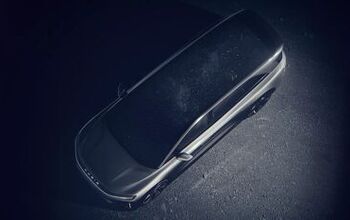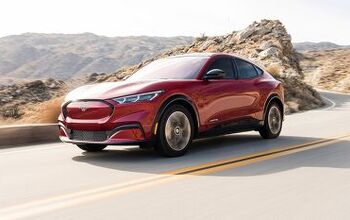How CAFE Helps The Market Function
Dare to suggest that a strong CAFE standard won’t ruin any automaker, and you’ll be overwhelmed by deafening cries of “what about the market,” “think of consumer choice,” and “don’t you tell me what to drive.” Now, I’ve made it very clear that I’m not a huge CAFE fan, but the fact of the matter is that since nobody is leading a charge for a gas tax (least of all the industry that says it would be a good thing) it’s the only option on the table. Which leaves just one question: why regulate fuel economy at all? There are all kinds of arguments against regulating fuel economy, but most stem from a desire to “let the market do its thing.” That’s an argument I’m highly sympathetic towards, but it doesn’t necessarily require that the government but out and let the era of cheap, thirsty trucks roll on unabated. What maybe, just maybe, if the market actually wants more fuel economy? Well guess what campers… according to research by IHS Global Insight [via Automotive News [sub], the market does want more fuel economy.
The major trend is visible enough in the graph above to prove the point: 8 cylinder engines have allen to a mere 18 percent of the market, while four-cylinder engines now make up the plurality of engine choices, at 43%. But if you’re looking at retail buyers only, there’s even more evidence that private consumers are more interested in fuel economy:
So far this year, more than half the vehicles sold to retail consumers had four cylinders, up sharply from a third in 2006, says J.D. Power and Associates.
So the whole line that “Americans like big, inefficient cars and trucks and therefore governmental regulation of fuel economy hurts consumers as well as the (primarily “domestic”) automakers who sell most of these vehicles” turns out to be bunk (incidentally, small and mid-sized vehicles account for 44 percent of sales this year vs. 36 percent in 2005). The market is objectively running away from big, thirsty vehicles with haste. Meanwhile, the two factors that are causing this shift have an interesting story to tell about the government’s role in the market. According to AN’s report:
Two factors are driving the shift. Buyers beset by high fuel prices are downsizing vehicles or opting for the smaller of two engine choices. And manufacturers are shrinking vehicles and engines to meet tougher 2016 federal fuel economy rules.
This is crucial: were this simply a question of high gas prices, we could sit back and argue that the government need not get involved. If automakers were truly responsive to their customers, the market would effectively provide the vehicles that consumers demand in the face of high gas prices. But as AN points out, governmental regulations actually play a huge role in making the market work. After all, automakers have no intrinsic incentive to offer highly-efficient vehicles: they typically cost more to build than, say, a Body-On-Frame truck, and command lower prices. And because the traditional mode of American consumption is to “buy as little fuel economy as you can afford” (to paraphrase Bob Lutz), automakers have every incentive to improve fuel economy slowly. After all, Americans will happily buy an inefficient vehicle if they can afford it, which in turn yields greater profits to the manufacturer. And because the product is moving, the manufacturers have the luxury of arguing that they are just “giving the market what it wants.”
But without high-quality, fuel-efficient alternatives available on the same lot, claiming that the market is functioning properly is highly misleading. For consumers to actually signal their (and therefore, the market’s) true preference, they need to have real choices. But, as was discussed in the previous paragraph, automakers have little incentive to offer a true choice. Which is where CAFE comes in: by forcing to offer something that the OEMs insist the market doesn’t really want (an incidentally earns them less profit), the government guarantees the choice which allows the market to actually signal its preferences. And, as the forthcoming 2016 standards have forced automakers to introduce new generations of high-quality small and fuel-efficient cars, we’re seeing the market slowly swing away from the guzzlers we previously assumed it “demanded” and towards the smaller engines and greater fuel economy.
This sends two important messages: first, that CAFE helps the market function properly and second, that CAFE shouldn’t be feared. Though manufacturers and their allies paint frightening pictures of CAFE leading to a market divorced from consumer demand, if anything the lesson seems to be that demand for fuel efficiency could well outstrip CAFE’s requirement to provide it. With continued instability in the Middle East, it seems likely that another shock in gas prices could occur before the 2025 standard goes into place (if scarcity driven by huge increases in developing-world consumption doesn’t steadily raise the price first). And with a trend towards fuel efficient engines already well underway, it’s highly likely that the market will demand as much or more fuel economy than CAFE mandates at some point in the next 15 years.
More by Edward Niedermeyer
Latest Car Reviews
Read moreLatest Product Reviews
Read moreRecent Comments
- Fred This is one car I never see anymore. Where did they all go?
- Daniel Bridger The increased cost of electricity is raging faster than the government's manipulation of ICE fuel.
- Zipper69 Why the choice of a four door shell.Packing this tech into Stinger would have been awesome.
- Eric I have no desire to have an EV. Too expensive, no charging facilities within 50 miles are even planned, unproven technology, arguably even more environmentally harmful than ICE vehicles. Besides being a status symbol and to signal virtue, what's to like?
- Zipper69 Alfa Romeo Europa

































Comments
Join the conversation
Everyone when asked will say they want better fuel economy until you park a SmartCar in front of them and they realize what they'll be stuck driving. If people want economy so badly they'd buy the cars that get the best economy and the market would force other automakers to build them. We don't need big nanny telling us what to drive.
Let's remember a side effect of CAFE: it keeps the cost of the marginal mile driven (i.e., the cost of going one more mile once you already own the car) very low. You only need pennies' worth of gas to drive a mile! So you'll be perfectly happy to drive more miles. In short, forcing fuel economy up results in more driving. It's why we have sprawling suburbs. People think nothing of hopping in the car to do the slightest errand, because operating cost is low. And the savings are, in part, illusory: if 50% higher fuel economy has you driving 25% further, the savings from your more efficient vehicle start getting eaten up. Schemes like CAFE sound smart, smart, smart until you start looking at the unintended consequences.